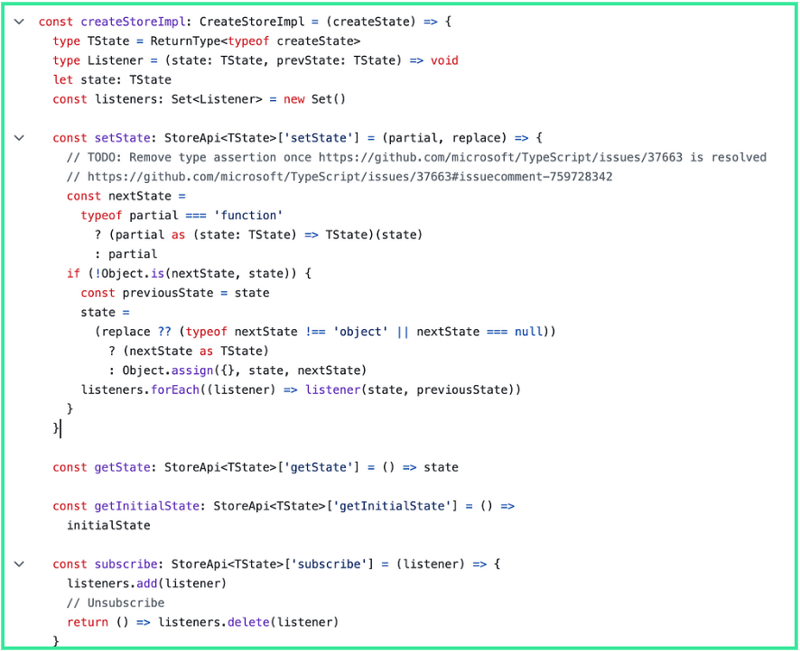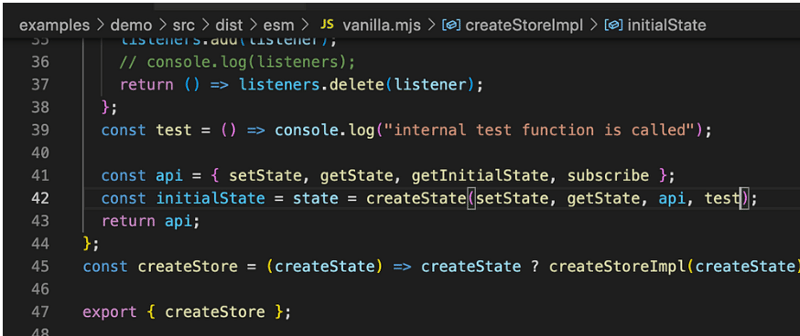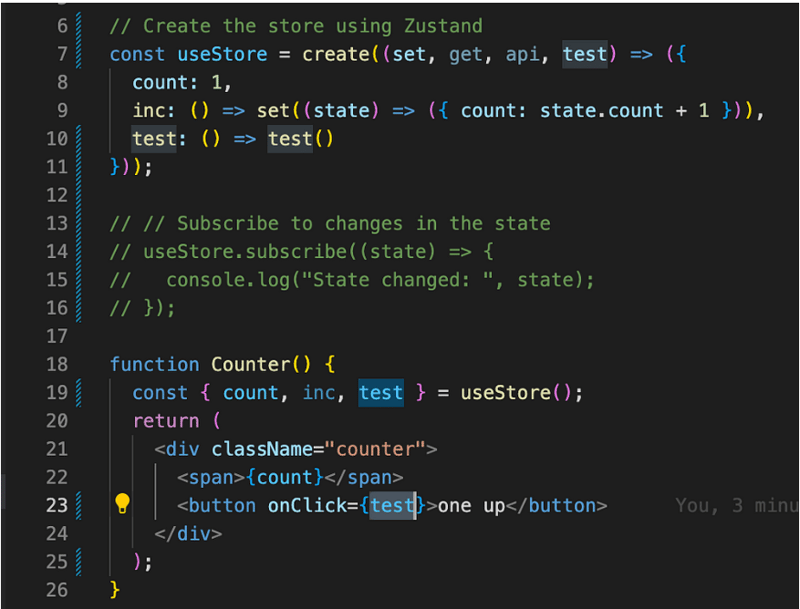state的源代码中对createStore进行了解释。
In this article, we will understand how createStore in Zustand’s source code is written/works.

createStore is exported from vanilla.ts and you will find this at the end of the file.
export const createStore = ((createState) => createState ? createStoreImpl(createState) : createStoreImpl) as CreateStore
createStore is arrow function that accepts a parameter called createState. if createState exists, createStoreImpl(createState) is called.
createStoreImpl
const createStoreImpl: CreateStoreImpl = (createState) => {
type TState = ReturnType<typeof createState>
type Listener = (state: TState, prevState: TState) => void
let state: TState
const listeners: Set<Listener> = new Set()
const setState: StoreApi<TState>['setState'] = (partial, replace) => {
// TODO: Remove type assertion once https://github.com/microsoft/TypeScript/issues/37663 is resolved
// https://github.com/microsoft/TypeScript/issues/37663#issuecomment-759728342
const nextState =
typeof partial === 'function'
? (partial as (state: TState) => TState)(state)
: partial
if (!Object.is(nextState, state)) {
const previousState = state
state =
(replace ?? (typeof nextState !== 'object' || nextState === null))
? (nextState as TState)
: Object.assign({}, state, nextState)
listeners.forEach((listener) => listener(state, previousState))
}
}
const getState: StoreApi<TState>['getState'] = () => state
const getInitialState: StoreApi<TState>['getInitialState'] = () =>
initialState
const subscribe: StoreApi<TState>['subscribe'] = (listener) => {
listeners.add(listener)
// Unsubscribe
return () => listeners.delete(listener)
}
const api = { setState, getState, getInitialState, subscribe }
const initialState = (state = createState(setState, getState, api))
return api as any
}
In our previous articles, I have written about how setState, subscribe work. We will cover the remaining functions such as getState, getInitialState, createState.
getState
getState simply returns the state that is declared at the top of this createStoreImpl function.
const getState: StoreApi<TState>['getState'] = () => state
getInitialState
getInitialState returns the initialState.
const getInitialState: StoreApi<TState>['getInitialState'] = () =>
initialState
createState
createState is used to initialise the state variable.
const createStoreImpl: CreateStoreImpl = (createState) => {
createState is a parameter in createStoreImpl. Let’s run some experiments using the demo example provided in the Zustand’s repo.

This is basically just what you pass into “create”
// Create the store using Zustand
const useStore = create((set) => ({
count: 1,
inc: () => set((state) => ({ count: state.count + 1 })),
}));
State initialisation happens in vanilla.ts at L93, even though create is originally exported from React, react.ts internally calls createStore in vanilla.ts.
So how does calling createState initializes the state?
const initialState = (state = createState(setState, getState, api))
The trick lies in calling the arrow function, createState. From the above code snippet, you can see that createState is called with setState, getState, api
Let’s run some experiments with this information. Let’s pass a custom function named test as the parameter without the original parameters.

The above image shows the custom test function I added to demonstrate how the parameters are passed to createState function.
let’s now see this internal test function in action. For us to access this test function, the following example shows how createStore can be initialised with this newly added test parameter.
// Create the store using Zustand
const useStore = create((set, get, api, test) => ({
count: 1,
inc: () => set((state) => ({ count: state.count + 1 })),
test: () => test()
}));
Because we exposed test in vanilla.mjs as shown below, you will have access to this function when you initialise the create function

I am triggering this test function when the button in the demo example is clicked.

This, in turn, calls the test function.
This is some advanced JavaScript arrow functions usage and oh, we also just added a custom test function and used in the demo app. That is cool.
About us:
At Think Throo, we are on a mission to teach the best practices inspired by open-source projects.
10x your coding skills by practising advanced architectural concepts in Next.js/React, learn the best practices and build production-grade projects.
We are open source — https://github.com/thinkthroo/thinkthroo (Do give us a star!)
Looking to build bespoke web systems for your business? Contact us at hello@thinkthroo.com
About the author:
Hey, I’m Ram. I am a passionate software engineer/OSS Tinkerer.
Checkout my website: https://www.ramunarasinga.com/
References:
- https://github.com/pmndrs/zustand/blob/main/src/vanilla.ts#L97
以上是state的源代码中对createStore进行了解释。的详细内容。更多信息请关注PHP中文网其他相关文章!

热AI工具

Undresser.AI Undress
人工智能驱动的应用程序,用于创建逼真的裸体照片

AI Clothes Remover
用于从照片中去除衣服的在线人工智能工具。

Undress AI Tool
免费脱衣服图片

Clothoff.io
AI脱衣机

Video Face Swap
使用我们完全免费的人工智能换脸工具轻松在任何视频中换脸!

热门文章

热工具

记事本++7.3.1
好用且免费的代码编辑器

SublimeText3汉化版
中文版,非常好用

禅工作室 13.0.1
功能强大的PHP集成开发环境

Dreamweaver CS6
视觉化网页开发工具

SublimeText3 Mac版
神级代码编辑软件(SublimeText3)
 Python vs. JavaScript:学习曲线和易用性
Apr 16, 2025 am 12:12 AM
Python vs. JavaScript:学习曲线和易用性
Apr 16, 2025 am 12:12 AM
Python更适合初学者,学习曲线平缓,语法简洁;JavaScript适合前端开发,学习曲线较陡,语法灵活。1.Python语法直观,适用于数据科学和后端开发。2.JavaScript灵活,广泛用于前端和服务器端编程。
 JavaScript和Web:核心功能和用例
Apr 18, 2025 am 12:19 AM
JavaScript和Web:核心功能和用例
Apr 18, 2025 am 12:19 AM
JavaScript在Web开发中的主要用途包括客户端交互、表单验证和异步通信。1)通过DOM操作实现动态内容更新和用户交互;2)在用户提交数据前进行客户端验证,提高用户体验;3)通过AJAX技术实现与服务器的无刷新通信。
 JavaScript在行动中:现实世界中的示例和项目
Apr 19, 2025 am 12:13 AM
JavaScript在行动中:现实世界中的示例和项目
Apr 19, 2025 am 12:13 AM
JavaScript在现实世界中的应用包括前端和后端开发。1)通过构建TODO列表应用展示前端应用,涉及DOM操作和事件处理。2)通过Node.js和Express构建RESTfulAPI展示后端应用。
 了解JavaScript引擎:实施详细信息
Apr 17, 2025 am 12:05 AM
了解JavaScript引擎:实施详细信息
Apr 17, 2025 am 12:05 AM
理解JavaScript引擎内部工作原理对开发者重要,因为它能帮助编写更高效的代码并理解性能瓶颈和优化策略。1)引擎的工作流程包括解析、编译和执行三个阶段;2)执行过程中,引擎会进行动态优化,如内联缓存和隐藏类;3)最佳实践包括避免全局变量、优化循环、使用const和let,以及避免过度使用闭包。
 Python vs. JavaScript:社区,图书馆和资源
Apr 15, 2025 am 12:16 AM
Python vs. JavaScript:社区,图书馆和资源
Apr 15, 2025 am 12:16 AM
Python和JavaScript在社区、库和资源方面的对比各有优劣。1)Python社区友好,适合初学者,但前端开发资源不如JavaScript丰富。2)Python在数据科学和机器学习库方面强大,JavaScript则在前端开发库和框架上更胜一筹。3)两者的学习资源都丰富,但Python适合从官方文档开始,JavaScript则以MDNWebDocs为佳。选择应基于项目需求和个人兴趣。
 Python vs. JavaScript:开发环境和工具
Apr 26, 2025 am 12:09 AM
Python vs. JavaScript:开发环境和工具
Apr 26, 2025 am 12:09 AM
Python和JavaScript在开发环境上的选择都很重要。1)Python的开发环境包括PyCharm、JupyterNotebook和Anaconda,适合数据科学和快速原型开发。2)JavaScript的开发环境包括Node.js、VSCode和Webpack,适用于前端和后端开发。根据项目需求选择合适的工具可以提高开发效率和项目成功率。
 C/C在JavaScript口译员和编译器中的作用
Apr 20, 2025 am 12:01 AM
C/C在JavaScript口译员和编译器中的作用
Apr 20, 2025 am 12:01 AM
C和C 在JavaScript引擎中扮演了至关重要的角色,主要用于实现解释器和JIT编译器。 1)C 用于解析JavaScript源码并生成抽象语法树。 2)C 负责生成和执行字节码。 3)C 实现JIT编译器,在运行时优化和编译热点代码,显着提高JavaScript的执行效率。
 Python vs. JavaScript:比较用例和应用程序
Apr 21, 2025 am 12:01 AM
Python vs. JavaScript:比较用例和应用程序
Apr 21, 2025 am 12:01 AM
Python更适合数据科学和自动化,JavaScript更适合前端和全栈开发。1.Python在数据科学和机器学习中表现出色,使用NumPy、Pandas等库进行数据处理和建模。2.Python在自动化和脚本编写方面简洁高效。3.JavaScript在前端开发中不可或缺,用于构建动态网页和单页面应用。4.JavaScript通过Node.js在后端开发中发挥作用,支持全栈开发。






